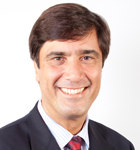When James Eckerle joined The Hartford Financial Services Group, Inc. in 2010, he had been retired for three days. “A better way to describe it would be to say that I was contemplating retirement, and I chose to do this instead,” says Eckerle, who came aboard as the executive vice president of strategic initiatives and enterprise technology. Today, he leads the company’s initiative to simplify and transform its operating mechanisms to improve efficiency and effectiveness. After a successful 25-year career at Bank of America—and considering the difficulties that The Hartford was experiencing at the time of Eckerle’s arrival—one would be inclined to ask the obvious question: why was his retirement so short lived?
“I never met a challenge that I didn’t like,” Eckerle says in response. By joining The Hartford at a time of rebuilding, Eckerle had a job well suited to his strong project-management skills and his meticulous, quantitative nature. But he also became a part of one of the largest and most tenured insurance companies in the country, an institution worth the application of not only his efforts, but his second career.
Improving upon a quality tradition
Based in Connecticut, The Hartford is a leading provider of insurance and wealth-management services for millions of consumers and businesses worldwide. The company is consistently recognized for its superior service, its sustainability efforts, and as being one of the world’s most ethical companies. “I’m now a part of a company that has been around for 202 years,” Eckerle says. “It’s amazing to be able to say that.”
Eckerle is proud to contribute to the company’s quality legacy. “I host a quarterly town hall with my team, and we sponsor an outreach event to support the local community,” he says. “Most recently, we collected a few thousand school supplies for local students for the coming school year … It was the opportunity to be a part of something great.”
Addressing issues
Eckerle was called to The Hartford to facilitate change in the organization. But first he needed to identify the problem and develop a more consistent approach. “There were inconsistencies across the technology infrastructure, different applications languages, and duplications of capabilities,” he says. “Really, it was hard to even tell how we were performing because of the inconsistencies.”
Reporting directly to The Hartford’s CEO, Eckerle’s charge was to build a branded approach to managing change for the company. His background and natural leadership mentality have helped him to do just that. After working full time through college—Eckerle was already managing an operations center for a bank at the time he graduated from college, in 1983—Eckerle joined the predecessors of Bank of America, in 1986, and grew with the company. During his tenure at Bank of America, Eckerle held a variety of jobs within the organization that included managing operations and standardizing policies. Eckerle’s career at Bank of America really caught fire at the turn of the century, when the bank went on a spending spree, acquiring companies and allowing Eckerle to grow into bigger roles and to build a foundation of extremely strong general-management skills.
 Perhaps more instrumental to Eckerle’ssuccess at The Hartford is his tenacity, commitment, and belief in the power of facts and data. “I am completely data driven,” he says. “The facts don’t lie. I never come to the conversation without a bevy of facts and data to support my ideas.”
Perhaps more instrumental to Eckerle’ssuccess at The Hartford is his tenacity, commitment, and belief in the power of facts and data. “I am completely data driven,” he says. “The facts don’t lie. I never come to the conversation without a bevy of facts and data to support my ideas.”
In addition, Eckerle’s inexperience became an asset. He assumed leadership of The Hartford’s IT department without having any formal technology training or IT background. “It was an advantage,” he says. “Our organization needed a person that could design a path forward, in business terms—not technology terms.”
Righting the Ship
A confluence of Eckerle’s approach and adamancy produced the change and results The Hartford needed. “I see a complex problem, and I dissect it into smaller problems,” says Eckerle of his tactics. “Then, I piece them together with a plan that gets you to a different place.”
The plan involved developing a new compute model that The Hartford will begin migrating toward in the next two years. “I didn’t have any technology biases, which helped us to design a new compute model with the best of all the components,” Eckerle says. “It can take us were we need to be, and also makes us more flexible and more cost effective.”
Eckerle also succeeded in developing the branded approach to managing change. The “weDeliver” approach is now used across the company, and such changes have yielded Eckerle’s favorite types of results: quantitative ones. On an internal-rating scale, a yellow incident is about as bad as it gets (Eckerle jokes that a red incident would effectively equate to a smoking hole where Hartford, Connecticut, used to be). In 2010, the year Jim Eckerle arrived, they had 33 yellow incidents. Through the first seven months of 2012, there have been only five yellow incidents. And Eckerle still sees room for improvement, “Five isn’t perfect, but it’s better than 33,” he says. “So we’re on our way. We are on a journey.”

